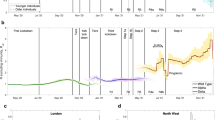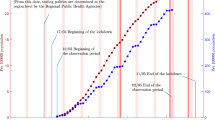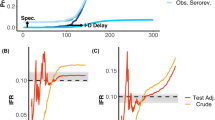Abstract
Since the identification of variant Creutzfeldt–Jacob Disease in the late 1980s, the possibility that this disease might be passed on via blood transfusion has presented challenging policy questions for Government and blood services in the UK. This paper discusses the use of mathematical modelling to inform policy in this area of health protection. We focus on the use of a relatively simple analytical model to explore how many such infections might eventually be expected to result in clinical cases under a range of alternative scenarios of interest to policy, and on the potential impact of possible additional counter measures. We comment on the value of triangulating between findings generated using distinct modelling approaches and observational data.




Similar content being viewed by others
References
ACDP (2011). Minutes from the 1st meeting of the ACDP Transmissible Spongiform Encephalopathy Risk Assessment Subgroup. July 2011. Available at: http://www.dh.gov.uk/ab/ACDP/TSEguidance/DH_125868, accessed 15 November 2011.
ACDP (2012a). Minutes from the 2nd meeting of the ACDP Transmissible Spongiform Encephalopathy Risk Assessment Subgroup. Available at http://transparency.dh.gov.uk/2012/08/13/tse-subgroup-may-2012, accessed 11 February 2013.
ACDP (2012b). Advisory Committee on Dangerous Pathogens TSE Risk Assessment Subgroup “Position statement on occurrence of vCJD and prevalence of infection in the UK population”. Available at: http://transparency.dh.gov.uk/2012/08/13/tse-risk-assessment-july-2012/, accessed 15 November 2011.
Bennett P and Dobra SA (2006). Risk assessment for variant CJD in blood transfusion: A perspective from the UK. In: Turner ML (ed). Creutzfeldt-Jakob Disease: Managing the Risk of Transmission from Blood, Plasma and Tissues. AABB Press: Bethesda, MD, pp 245–285.
Bennett P, Hare A and Townshend J (2004). Assessing the risk of vCJD transmission via surgery: Models for uncertainty and complexity. Journal of the Operational Research Society 56 (2): 202–213.
Bishop MT et al (2006). Predicting susceptibility and incubation time of human-to-human transmission of vCJD. The Lancet Neurology 5 (5): 393–398.
Bruce ME et al (1997). Transmissions to mice indicate that ‘new variant’ CJD is caused by the BSE agent. Nature 389 (6650): 498–501.
Clarke P and Ghani AC (2005). Projections of the future course of the primary vCJD epidemic in the UK: Inclusion of subclinical infection and the possibility of wider genetic susceptibility. Journal of the Royal Society, Interface/the Royal Society 2 (2): 19–31.
Collinge J (2001). Prion diseases of humans and animals: Their causes and molecular basis. Annual Review of Neuroscience 24 (1): 519–550.
Collinge J et al (2006). Kuru in the 21st Century—An acquired human prion disease with very long incubation periods. The Lancet 367 (9528): 2068–2074.
d'Aignaux JNH et al (2002). The incubation period of Kuru. Epidemiology 13 (4): 402–408.
Department of Health (2006). Exclusion of blood component recipients from donation: The impact on potential vCJD transmission risks. 1 July, http://www.dh.gov.uk/en/Publicationsandstatistics/Publications/PublicationsPolicyAndGuidance/DH_4136942, accessed 11 February 2013.
Department of Health (2009). Mapping out the consequences of screening blood donations for PrPSc, http://www.dh.gov.uk/en/Publicationsandstatistics/Publications/PublicationsPolicyAndGuidance/DH_094804, accessed 11 February 2013.
Department of Health (2011). Blood-borne transmission of vCJD: Re-examination of scenarios, http://www.dh.gov.uk/health/2011/09/vcjd-scenarios/, accessed 11 February 2013.
Det Norske Veritas Consulting (2004). Risk of infection from variant CJD in blood. Available at: http://ia201119.eu.archive.org/tna/20061004085342/dnv.com/consulting/news/riskofinfectionfromvariantcjdinblood.asp, accessed 18 July 2011.
Dodd RY (2010). Prions and precautions: Be careful for what you ask. Transfusion 50 (5): 956–958.
Garske T and Ghani AC (2010). Uncertainty in the tail of the variant Creutzfeldt-Jakob disease epidemic in the UK. PloS One 5 (12): e15626.
Ghani AC, Ferguson NM, Donnelly CA, Hagenaars TJ and Anderson RM (1998). Epidemiological determinants of the pattern and magnitude of the vCJD epidemic in Great Britain. Proceedings of the Royal Society of London. Series B: Biological Sciences 265 (1413): 2443–2452.
Ghani AC, Ferguson NM, Donnelly CA and Anderson RM (2000). Predicted vCJD mortality in Great Britain. Nature 406 (6796): 583–584.
Gregori L et al (2004). Effectiveness of leucoreduction for removal of infectivity of transmissible spongiform encephalopathies from blood. Lancet 364 (9433): 529–531.
Gregori L, Yang H and Anderson S (2011). Estimation of variant Creutzfeldt-Jakob disease infectivity titers in human blood. Transfusion, http://onlinelibrary.wiley.com/doi/10.1111/j.1537-2995.2011.03199.x/abstract, accessed 11 February 2013.
Head MW, Yull HM, Ritchie DL, Bishop MT and Ironside JW (2009). Pathological investigation of the first blood donor and recipient pair linked by transfusion-associated variant Creutzfeldt–Jakob disease transmission. Neuropathology and Applied Neurobiology 35 (4): 433–436, 526.
Health Protection Agency (2011). Interim data from the current national survey of abnormal prion prevalence in archived appendix specimens. September 2011, http://www.hpa.org.uk/hpr/archives/2011/news3611.htm#cjd.
Hewitt PE, Llewelyn CA, Mackenzie J and Will RG (2006). Creutzfeldt–Jakob disease and blood transfusion: Results of the UK transfusion medicine epidemiological review study. Vox Sanguinis 91 (3): 221–230.
Hill AF et al (1997). The same prion strain causes vCJD and BSE. Nature 389 (6650): 448–450, 526.
Hilton DA et al (2004). Prevalence of lymphoreticular prion protein accumulation in UK tissue samples. The Journal of Pathology 203 (3): 733–739.
Houston F et al (2008). Prion diseases are efficiently transmitted by blood transfusion in sheep. Blood 112 (12): 4739–4745.
Ironside JW (2006). Variant Creutzfeldt-Jakob disease: Prion protein genotype analysis of positive appendix tissue samples from a retrospective prevalence study. British Medical Journal 332 (7551): 1186–1188.
Kaski D et al (2009). Variant CJD in an individual heterozygous for PRNP codon 129. Lancet 374 (9707): 2128.
Knight R (2010). The risk of transmitting prion disease by blood or plasma products. Transfusion and Apheresis Science 43 (3): 387–391.
Lefrère J-J and Hewitt P (2009). From mad cows to sensible blood transfusion: The risk of prion transmission by labile blood components in the United Kingdom and in France. Transfusion 49 (4): 797–812.
Llewelyn CA et al (2004). Possible transmission of variant Creutzfeldt-Jakob disease by blood transfusion. Lancet 363 (9407): 417–421.
Peden A et al (2010). Variant CJD infection in the spleen of a neurologically asymptomatic UK adult patient with haemophilia. Haemophilia 16 (2): 296–304.
Peden AH, Head MW, Diane LR, Jeanne EB and James WI (2004). Preclinical vCJD after blood transfusion in a PRNP codon 129 heterozygous patient. The Lancet 364 (9433): 527–529.
Stevenson MD, Oakley JE, Chick SE and Chalkidou K (2009). The cost-effectiveness of surgical instrument management policies to reduce the risk of vCJD transmission to humans. Journal of the Operational Research Society 60 (4): 506–518.
UK NCJDRSU and UK Blood Services (2011). Transfusion medicine epidemiology review, http://www.cjd.ed.ac.uk/TMER/fate.htm, accessed 14 April 2011.
Wallis JP (2011). Strategies to reduce transfusion acquired vCJD. Transfusion Medicine 21 (1): 1–6.
Wallis JP, Wells AW, Matthews JN and Chapman CE (2004). Long-term survival after blood transfusion: A population based study in the North of England. Transfusion 44 (7): 1025–1032.
Watkins NA, Dobra SA, Bennett P, Cairns J and Turner ML (2012). The management of blood safety in the presence of uncertain risk: A United Kingdom perspective. Transfusion Medicine Reviews 26 (3): 238–251.
Wells AW et al (2009). The EASTR study: Indications for transfusion and estimates of transfusion recipient numbers in hospitals supplied by the National Blood Service. Transfusion Medicine 19 (6): 315–328.
Will B (2010). Variant CJD: Where has it gone, or has it? Practical Neurology 10 (5): 250–251.
Wroe SJ et al (2006). Clinical presentation and pre-mortem diagnosis of variant Creutzfeldt-Jakob disease associated with blood transfusion: A case report. Lancet 368 (9552): 2061–2067.
Acknowledgements
This is an independent report commissioned and funded by the Policy Research Programme in the Department of Health. The views expressed are not necessarily those of the Department.
Author information
Authors and Affiliations
Rights and permissions
About this article
Cite this article
Crowe, S., Bennett, P., Daraktchiev, M. et al. Use of modelling to inform public health policy: a case study on the blood-borne transmission of variant-CJD. J Oper Res Soc 65, 269–277 (2014). https://doi.org/10.1057/jors.2013.26
Received:
Accepted:
Published:
Issue Date:
DOI: https://doi.org/10.1057/jors.2013.26




